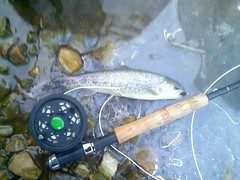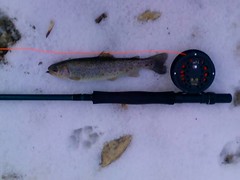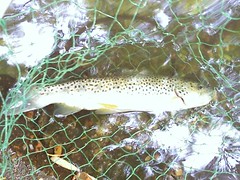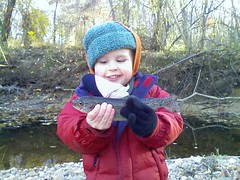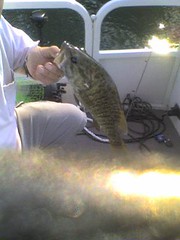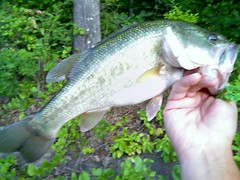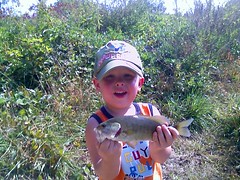My strategy in this sport must involve more than fish to be successful. First, I have set the family conditions for a quick outing. This morning this involved feeding my infant son Zach an extra two ounces of formula. Luckily little Zachy's stomach was held at bay long enough for Dad to score a quick rainbow and return before the little guy woke the family up.
That in itself is success for me. My loyalty to the Wholly Bugger was also big this morning. Didn't have a lot of time on the stream but I was happy with how quickly I was able to hook up. On the down side, we seem to be getting mainly runts from the state hatcheries this year. But, I was pleased with how healthy this trout was: good color, fought well. We are still living off the fall stock. The winter stocking is in a few weeks. Things are looking good for peak trout fishing this spring.
Sunday, January 27, 2008
Monday, January 21, 2008
10 Degree Rainbows
I view it as my god given right to go fishing on a federal holiday, or at least get in an hour or so in the morning before the family wakes up. Why would I let the fact that it was 10 degrees this morning get in the way? Yeah, there was that problem with the stream being almost completely iced over.
OK, so I am standing in front of the stream in my neoprene waders with my fly rod looking like an idiot. Given that most flies are less effective when they are separated from the fish by a layer of ice I had to analyze the situation. I watched a bass fishing show yesterday when bass legend Rick Clunn talked about pattern fishing. Pattern fishing is based on the assumption that fish behave similarly in groups. So, if you catch say a bass feeding around a wind blown stump, identical structure elsewhere will likely have other bass feeding the same way.
So, that brings me back to staring at a frozen stream trying to figure out what to do. My first rule of fly fishing is when in doubt tie on a black bead headed wholly bugger--the one fly I know works on just about anything. Given the fact that the only part of the stream that was not frozen over were riffles and associated tails, I hoped that the principle of the pattern meant that the Trout were feeding just below the ice behind the tail of the riffle (elements of trout feeding: cover, current, food supply...check!). I made about two casts with my Wholly Bugger and decisively hooked a hungry little rainbow. I guess the other principle to consider here is the stupidity of trout that have spent their lives in a hatchery. But the pattern principle puts me in a better light so I will go with that. Unfortunately, after about ten minutes my fly became lodged in the ice and broke off. Another tip I have gotten from a fishing show recently is that when you find fish be willing to experiment. Don’t keep throwing the same thing to feeding fish until they are conditioned not to strike. In this case a different fly might add another piece to the pattern puzzle. So, I tried nymphing a Copper John. Given the fact that the water is partially iced nymphing here was an improvised combination between dead drifting and ice fishing with a fly rod. In other words I floated my fly under the ice by using the current. But I like the fly speak better—it makes me feel outdoorsy. I floated my copper john down stream a couple of times and hooked another rainbow. Let me emphasize, IT WAS TEN FRICKEN DEGREES.
So, this played out in less than thirty minutes and the lure of blogging in my warm house pulled me away. That and after thirty minutes my guides were completely clogged with ice and my tippet turned into a flycicle, and then there is that whole family thing to consider. Ok so these rainbows are small, but this is Fairfax County. If I lived in Montana I wouldn’t be blogging this. But I live in the suburban DC area and I consider this a small victory over the elements, urban sprawl, and those morons on VAFly.com who say you have to drive for two hours to catch a trout if you live in the DC area.
OK, so I am standing in front of the stream in my neoprene waders with my fly rod looking like an idiot. Given that most flies are less effective when they are separated from the fish by a layer of ice I had to analyze the situation. I watched a bass fishing show yesterday when bass legend Rick Clunn talked about pattern fishing. Pattern fishing is based on the assumption that fish behave similarly in groups. So, if you catch say a bass feeding around a wind blown stump, identical structure elsewhere will likely have other bass feeding the same way.
So, that brings me back to staring at a frozen stream trying to figure out what to do. My first rule of fly fishing is when in doubt tie on a black bead headed wholly bugger--the one fly I know works on just about anything. Given the fact that the only part of the stream that was not frozen over were riffles and associated tails, I hoped that the principle of the pattern meant that the Trout were feeding just below the ice behind the tail of the riffle (elements of trout feeding: cover, current, food supply...check!). I made about two casts with my Wholly Bugger and decisively hooked a hungry little rainbow. I guess the other principle to consider here is the stupidity of trout that have spent their lives in a hatchery. But the pattern principle puts me in a better light so I will go with that. Unfortunately, after about ten minutes my fly became lodged in the ice and broke off. Another tip I have gotten from a fishing show recently is that when you find fish be willing to experiment. Don’t keep throwing the same thing to feeding fish until they are conditioned not to strike. In this case a different fly might add another piece to the pattern puzzle. So, I tried nymphing a Copper John. Given the fact that the water is partially iced nymphing here was an improvised combination between dead drifting and ice fishing with a fly rod. In other words I floated my fly under the ice by using the current. But I like the fly speak better—it makes me feel outdoorsy. I floated my copper john down stream a couple of times and hooked another rainbow. Let me emphasize, IT WAS TEN FRICKEN DEGREES.
So, this played out in less than thirty minutes and the lure of blogging in my warm house pulled me away. That and after thirty minutes my guides were completely clogged with ice and my tippet turned into a flycicle, and then there is that whole family thing to consider. Ok so these rainbows are small, but this is Fairfax County. If I lived in Montana I wouldn’t be blogging this. But I live in the suburban DC area and I consider this a small victory over the elements, urban sprawl, and those morons on VAFly.com who say you have to drive for two hours to catch a trout if you live in the DC area.
Saturday, January 19, 2008
Brown Trout: Why Not Stock More?
As I indicated in my earlier post, trout rival bass for my enthusiasm. Unfortunately, eastern trout continue to be under threat. Unlike Bass, which are warmwater fish, trout are coldwater fish that require clear, highly oxygenated water. That creates problems here in the east where urbanization and warmer weather threatens habitat that once supported large numbers of brook trout.
The state of native brook trout puts pressure on fishery biologists to manage potential competitors such as brown trout. In the Shenendoah National Park new regulations seek to purge browns in defense of the brookie. In the few waters this far south that support wild brook trout that is probably the right solution. But what about lower elavations where trout typically do not hold through the summer? In this area the state stocks mainly Rainbows which are then harvested by anglers before the water is too warm to support them. But some of these waters are ground fed and have far lower water temperatures than many realize. Here in the DC suburbs of VA I bagged trout in late June last year when they should have been long gone. But what if instead of stocking mainly rainbows the state stocked browns? Brown trout can survive in water that is warmer and more turbid than their rainbow cousins. Browns hold successfully in streams just north of us in Montgomery, and Baltimore County, MD. Gunpower Falls provides a tailwater habitat that browns thrive in, but the water is admittedly much cooler than typically found here in Virginia.
My suspicion is that biologists are hesitant to stock browns because they are non-native to North America. Unlike Rainbows that are native to the west coast, browns were brought by European settlers. In many cases they do threaten native brook trout. But in areas where brook trout can not survive, they may be far less invasive. Streams that are ground or dam fed may allow browns to hold where rainbows will not. If these fish are successfully introduced they can provide a vehicle for stream restoration. Restoration efforts may include a buffer of trees, a stream clean up, or efforts to contain residential drainage. Any reasons why the brown trout is invasive can be offset by protecting the stream from pollution and urban run off. I am sure there are many other factors to look at but it is worth considering using brown trout to reclaim mid-atlantic streams and surrounding habitat that may be otherwise threatened. Here in the Chesapeake watershed it may be a baby step toward addressing a larger problem.
Ok, that may be an ironic conclusion on a blog named "Bass Slayer." I would like to point out I don't actually slay the bass, I practice catch and release...and I want to catch bass and trout when I retire. That is a long way away so we need better conservation or the only thing I will catch is some mysterious illness
The state of native brook trout puts pressure on fishery biologists to manage potential competitors such as brown trout. In the Shenendoah National Park new regulations seek to purge browns in defense of the brookie. In the few waters this far south that support wild brook trout that is probably the right solution. But what about lower elavations where trout typically do not hold through the summer? In this area the state stocks mainly Rainbows which are then harvested by anglers before the water is too warm to support them. But some of these waters are ground fed and have far lower water temperatures than many realize. Here in the DC suburbs of VA I bagged trout in late June last year when they should have been long gone. But what if instead of stocking mainly rainbows the state stocked browns? Brown trout can survive in water that is warmer and more turbid than their rainbow cousins. Browns hold successfully in streams just north of us in Montgomery, and Baltimore County, MD. Gunpower Falls provides a tailwater habitat that browns thrive in, but the water is admittedly much cooler than typically found here in Virginia.
My suspicion is that biologists are hesitant to stock browns because they are non-native to North America. Unlike Rainbows that are native to the west coast, browns were brought by European settlers. In many cases they do threaten native brook trout. But in areas where brook trout can not survive, they may be far less invasive. Streams that are ground or dam fed may allow browns to hold where rainbows will not. If these fish are successfully introduced they can provide a vehicle for stream restoration. Restoration efforts may include a buffer of trees, a stream clean up, or efforts to contain residential drainage. Any reasons why the brown trout is invasive can be offset by protecting the stream from pollution and urban run off. I am sure there are many other factors to look at but it is worth considering using brown trout to reclaim mid-atlantic streams and surrounding habitat that may be otherwise threatened. Here in the Chesapeake watershed it may be a baby step toward addressing a larger problem.
Ok, that may be an ironic conclusion on a blog named "Bass Slayer." I would like to point out I don't actually slay the bass, I practice catch and release...and I want to catch bass and trout when I retire. That is a long way away so we need better conservation or the only thing I will catch is some mysterious illness
Winter Trout
Bass are hard to come by this time of year. Especially when you get maybe a few hours to fish on a good day. All of the fishing mags talk about how you can catch them in the dead of winter with deep jigging, and dead sticking crankbaits. I have yet to figure this out. So, in this respect I am far from being a true "Bass Slayer."
That leaves us with chasing Trout in our local stocked Trout stream. Last Spring I read the blogs about how this stream was not worth your time. But putting an hour or two in here and there I bagged many Rainbows, and a couple Browns. This is a delayed harvest stream, which means the state puts in Trout in the Fall, Winter, and Spring, and then lifts catch and release restrictions in June as the water begins to warm beyond the range of Trout. Considering the location it is amazing the stream holds Trout as long as it does. Credit the efforts of my friend Duane and his stream monitoring group.
So far this year, the Trout have been harder to come by as they are less active than when the water warms in the Spring. They are also smaller as the VDGIF has apparently been less generous this past fall. But, at least you can still score an occasional Rainbow in the dead of winter. The Bass will have to wait. That is unless I can solve the mystery of the winter pig and jig, jigging spoon, and dead sticked deep diving crank bait. But I must figure this out before I retire.
That leaves us with chasing Trout in our local stocked Trout stream. Last Spring I read the blogs about how this stream was not worth your time. But putting an hour or two in here and there I bagged many Rainbows, and a couple Browns. This is a delayed harvest stream, which means the state puts in Trout in the Fall, Winter, and Spring, and then lifts catch and release restrictions in June as the water begins to warm beyond the range of Trout. Considering the location it is amazing the stream holds Trout as long as it does. Credit the efforts of my friend Duane and his stream monitoring group.
So far this year, the Trout have been harder to come by as they are less active than when the water warms in the Spring. They are also smaller as the VDGIF has apparently been less generous this past fall. But, at least you can still score an occasional Rainbow in the dead of winter. The Bass will have to wait. That is unless I can solve the mystery of the winter pig and jig, jigging spoon, and dead sticked deep diving crank bait. But I must figure this out before I retire.
Thursday, January 17, 2008
Fly Casting: The Creep and Jab
FlyFishermen.com has good short video clip that helps correct a common fly casting error:
http://www.flyfisherman.com/videos/Jim_Cast.mov
In this casting video, Jim McLennan shows how to diagnose and cure the creep and jab--a serious casting affliction that can cause normally good casters to throw tailing loops
http://www.flyfisherman.com/videos/Jim_Cast.mov
In this casting video, Jim McLennan shows how to diagnose and cure the creep and jab--a serious casting affliction that can cause normally good casters to throw tailing loops
Monday, January 14, 2008
Dad's Smallie
Dad retired on Lake James in the mountains, which is probably the best Smallie lake in NC. Dad's specialty is largemouth--standard fare in the lakes we fished around Raleigh. He is still making the transisition to smallies but this fish was a huge step.
Saturday, January 12, 2008
Largemouth on a Green Plastic Worm
Can't beat the chartreuse colored plastic worm when pounding the shore line. It was always the go to bait in NC when Dad and I fished together in the old days. I have switched to tubes these days but TX rigged plastic worm probably still accounts for most bass I have caught.
Pesky smallie on the fly
As a new fly fishermen who loves trout and bass I find smallies on fly to be great fun. David and I fished Lake Thompson in the VA foothills this fall and managed to get a few dozen green sunfish. Tied a wholly bugger and continued to get hammered by the greenies--then this little guy smashed it. He doesn't look like much but he made some great runs that bent my 5 weight. This fish was significant for me. Not the first smallie I have gotten on fly, but he was scrappy enough for me to plan chasing smallies on the upper Potomac into my spring. I am looking forward to the day David graduates from green sunfish and bags a smallie.
Colorado Largemouth
This was the best Bass I actually landed in 2007. We were in Colorado visiting family. We had struggled to catch Trout in the Mountains. Cousin BJ and I hit a small lake in Arvada. This Bass smashed a 3 1/2" White Tube. He measured 19 1/2 " and must have weighed about 5 lbs.
This was a redemption fish. I fish a lot of TX rigged tubes which are good for fishing cover but costs you good hook sets which lost me some nice Bass this year. Credit cousin BJ for helping me land this one. I botched some landings last year, so it was good to finally bag one in the 5lbs class .
This was a redemption fish. I fish a lot of TX rigged tubes which are good for fishing cover but costs you good hook sets which lost me some nice Bass this year. Credit cousin BJ for helping me land this one. I botched some landings last year, so it was good to finally bag one in the 5lbs class .
2007 The Year in Bass
David and I had lots of fun this year reeling in lots of fish here in Virginia. We started the year catching a bunch of Trout, but our most fun catches were clearly Bass. Most of these catches were at the lake across the street from our house. David gets very excited when we manage to get a Largemouth Bass in his hands. We are hoping this enthusiasm translates into big earnings on the Bassmaster circuit after Daddy retires.
We hope 2008 is better as we now have our boat here, and David is getting big enough to leave the shore.
We hope 2008 is better as we now have our boat here, and David is getting big enough to leave the shore.
Subscribe to:
Posts (Atom)
